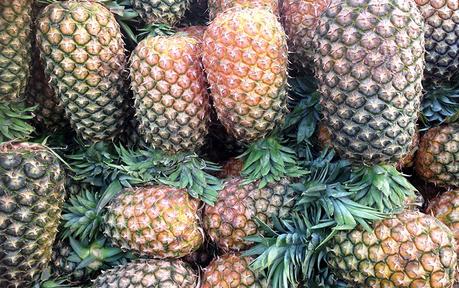
A virtual food tour of Uganda
Regular readers of Diary of a Muzungu know I'm always up for an adventure - and this one is in my tastebuds!
I was delighted when expat blogger Sarah 'With a Smile' Emery from sunny Singapore, invited me to take part in a virtual food tour. Here are some highlights of our interview about my experience eating different traditional foods in Uganda.
Sarah: What is your favourite traditional dish in Uganda?The muzungu: " Katogo is popular, very filling and easy and cheap to prepare. The main ingredient is usually matooke (steamed green banana) or cassava or Irish potatoes, served with beans or beef. My favourite katogo combination is matooke with 'g nuts' (ground nuts or peanuts) and greens. Many Ugandans like breakfast katogo made with "gizzards" (not something I can stomach - no pun intended!) Katogo is served hot, normally in a bowl. It's my kind of comfort food."
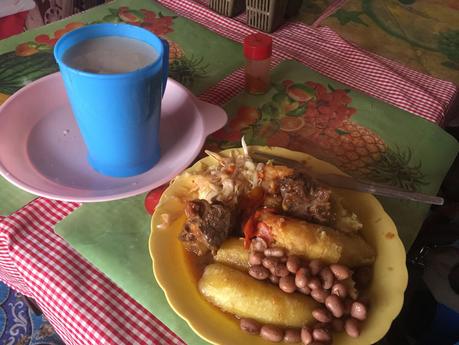
Sarah: What is the most interesting food that you have eaten in Uganda?
The muzungu: "If you had told me 10 years ago that I would move to Africa and start eating insects, I may never have moved here! Insects - particularly cockroaches - were my biggest fear when I first moved to Uganda but now, I find myself eating - and LOVING - grasshoppers! Twice a year, when the rains are at their peak, the country has a glut of bright green grasshoppers or nsenene. At night, powerful lights attract the grasshoppers who are dazzled by the reflective glare of tin sheets and collected by the thousands.
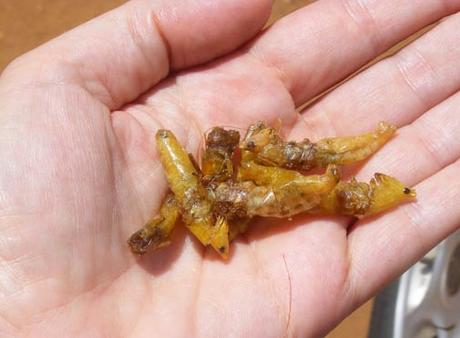
Nsenene are peeled - just like prawns - by removing their legs and wings and then fried, often with onions. Grasshoppers give off a smoky flavour and once you start eating them, you may not want to stop. They're delicious with an evening aperitif. They are high in protein and low in fat.
I haven't tried them (yet) but (white ants or termites) and lake flies are other Ugandan insect delicacies."

Sarah: What is the worst food you have tried in Uganda and why?
The muzungu: "I was a vegetarian for many years and can't imagine myself ever eating pig trotters. Friends say mulokony or kigere are quite a delicacy ("good hangover food") but the sight of them, whether raw or cooked, is enough to turn my stomach.
When I first moved to Kampala, a young Ugandan friend introduced me to the traditional food of Western Uganda. The kalo (millet bread), served in a pretty woven basket, looked like raw dough and was served with a sour sauce derived from ghee. The dish is "an acquired taste", shall we say, but even now, I can't eat it."
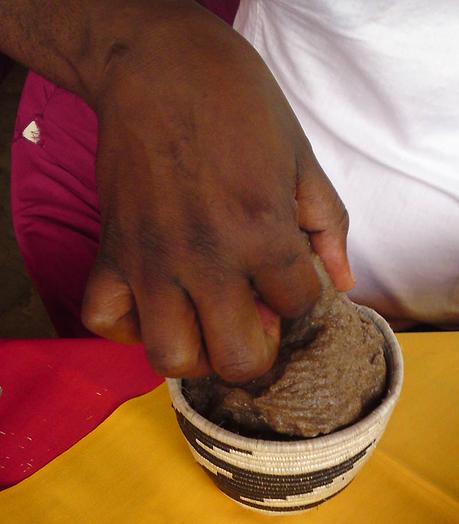
Sarah: What food and/or drink is a must-try for those who are visiting Uganda?
The muzungu: "The rolex is probably the country's most talked about dish, particularly after it appeared on CNN. A rolex (think "rolled eggs") is simply an omelette wrapped in a chapati, with the addition of sliced tomatoes and cabbage. The rolex was first made popular by Kampala's university students. Nowadays, you can buy a freshly prepared rolex by any roadside. A few smart café's in Kampala do 'posh rolex ' with bacon or avocado but you can't beat the original combo.
Read The rolex: celebrating Uganda's uniqueness!
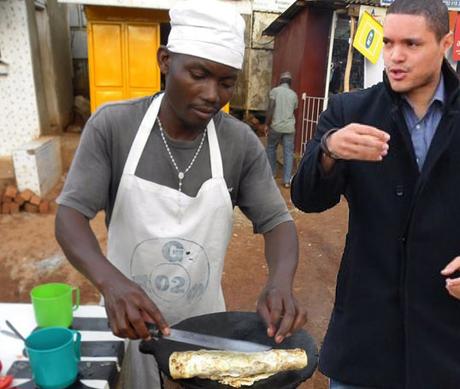
Another institution is Uganda Waragi, a triple-distilled gin which goes down a treat with tonic. It's a popular tipple with tourists and expats. Waragi is said to come from the words 'war gin' and was an import of the British. Local gin is made of bananas and stored in plastic jerry cans. It can be lethal (and is best avoided!)
Bushera millet porridge is another popular staple which I tried on Agartha's Taste of Uganda experience. Millet is a common crop and the porridge is drunk all over the country but at Agartha's we experienced the whole process from 'farm to cup.' Her home in Ishasha was a tasty stop-over on our food tour of Uganda.
Read How to be a Mukiga woman - meet Agartha!
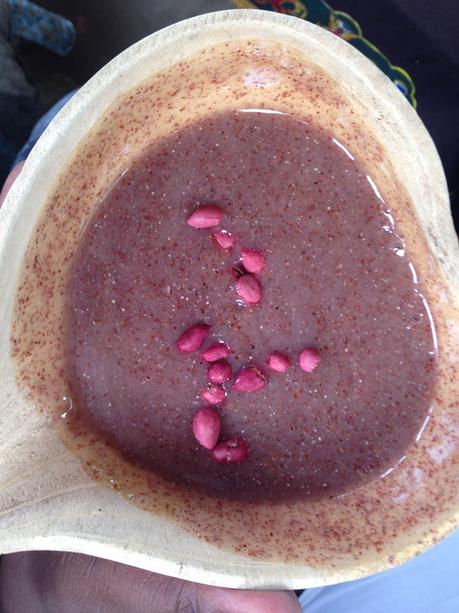
When I lived in Kampala, the capital of Uganda, a favourite day out was eating fish (Tilapia or Nile Perch) on Lake Victoria. Sometimes you want somewhere swanky, but sometimes you just want to sit at the landing site and eat the freshest fish with your hands. Read A guide to eating fish on Lake Victoria. "
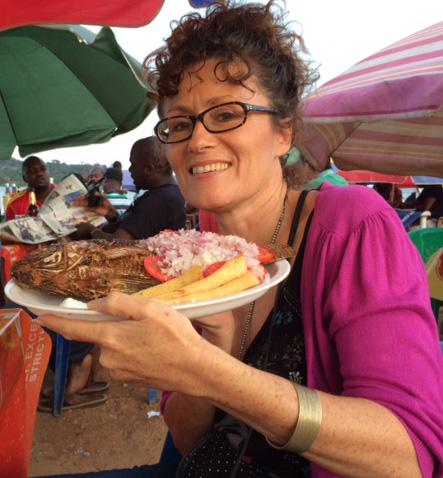
Sarah: Are there any dining customs a visitor would benefit from knowing prior to visiting Uganda?
The muzungu: "Many Ugandans eat with their hands but it's okay for you to eat with cutlery.
Lunch can sometimes take a long time to arrive, depending on the restaurant. A busy local restaurant will have ready-cooked food that they will quickly plate for you. However, if you make a specific order, expect to wait a long time. Unless you're eating somewhere fancy in Kampala or at a tourist lodge, it's good practice to ask "what is in the kitchen" since what is on the menu may have no bearing on what is available! The annoying part is that the waitress may not tell you for 15 minutes that this is the case. This seems to happen a lot outside the capital.
The food tour of Uganda continues. Read "Lunch arrived squawking on a boda boda."

Ugandans add a lot of salt when they cook so always taste your food before adding any. Ugandans eat big portions. Every meal is a big slab of food. By contrast, Brits have smaller plates of food but are more likely to snack between meals. We may also order a starter or a dessert. Ugandans will generally just eat one course. (If fresh fruit is served at a buffet, it is normally piled on top of the other food!)
Uganda is a country of 56 tribes. This means that the food culture differs from one part of the country to another. In the central region of Buganda, it is deemed rude to leave a guest looking at an empty plate so a waitress may rush to remove your plate as soon as you finish eating. Culturally, she is exhibiting good manners, but I don't like being rushed. (A Brit like me feels like the waitress is clearing the table ready for the next guest!)
Ugandan food is plentiful. The country has a wonderful climate meaning that there are at least two harvests per year. It's perhaps for this reason that Ugandans don't finish eating everything on their plate.
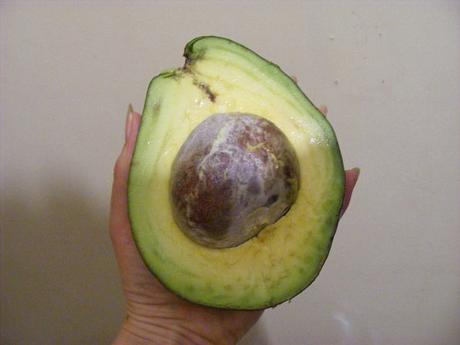
Ugandan avocados are HUGE and the pineapples and mangoes are the sweetest! Every visitor to Uganda comments on the fantastic fruit and vegetables. However, most Ugandans are happiest eating heavy carbohydrates (which they refer to by the collective name of 'food') and meat. Forget the paleo diet, Ugandans will load up their plates with as many as five types of 'food.'
Vegetables or salads seem to be a 'by the way' and associated with poverty for many people. The thinking goes that if you have real food (meat and 'food') you don't need to live on the free stuff (vegetables) that you can grow in your shamba.
When you visit a Ugandan home, it's customary to be offered something to eat or drink. Your host may get upset if you don't accept anything. Sometimes there will be an accompaniment with tea; this is sometimes called an 'escort.' (Uglish is a Ugandan version of English that often makes me smile)."
Click here to read Sarah with a Smile's full virtual food tour featuring expats in South Korea, New Zealand, Switzerland, Germany, Japan, Scotland and Hong Kong.
